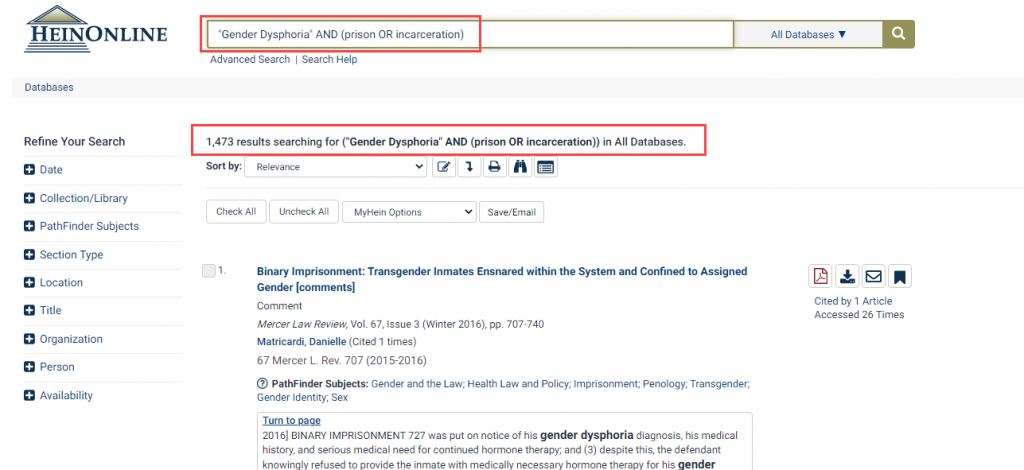Gender dysphoria is defined as the clinical distress that a person may experience due to the difference between their gender identity and their biological sex. Based on a recent ruling in the 4th U.S. Circuit Court of Appeals, this condition is protected by the Americans with Disabilities Act (ADA),[1]To establish a clear and comprehensive prohibition of discrimination on the basis of disability., Public Law 101-336, 101 Congress. 104 Stat. 327 (1990). This act can be found in HeinOnline’s U.S. Statutes at Large database. which is a major win for both the LGBTQ and disability communities. Let’s dive into this case, Williams v. Kincaid,[2]No. 21-2030. United States Court of Appeals, Fourth Circuit. This case can be found in Fastcase. and its implications with the help of HeinOnline.
Deliberate Mistreatment
Kesha Williams, a transgender woman, spent six months at Fairfax County Adult Detention Center in Virginia. Initially, when she arrived at the center, she was assigned to women’s housing. However, when deputies learned that she was transgender and had not had bottom surgery, they moved her to men’s housing. During this time, Williams’ hormone replacement treatment, which she had been utilizing for 15 years to help manage her gender dysphoria, was delayed several times, resulting in mental, emotional, and physical distress. In addition, she experienced harassment and misgendering from inmates and prison staff. She was subjected to rough searches by male deputies, even when she requested to be searched by females instead. Because of this deliberate mistreatment, when she was released, Williams sued the Sheriff of Fairfax County, a prison deputy, and a prison nurse for violating the ADA.

The Case Dismissed
The district court dismissed Williams’ case based on the ADA’s definition of “disability” which explicitly excludes “gender identity disorders not resulting from physical impairments.”[3]To establish a clear and comprehensive prohibition of discrimination on the basis of disability., Public Law 101-336, 101 Congress. 104 Stat. 327 (1990). This act can be found in HeinOnline’s U.S. Statutes at Large database. The court interpreted “gender identity disorders” to include gender dysphoria, and concluded that William’s condition was not caused by a physical impairment.

4th Circuit Reversal
In a 2-1 decision, the United States Court of Appeals for the Fourth Circuit disagreed with the district court’s decision. The court found three reasons to justify including gender dysphoria under the ADA.
1. Times Have Changed
When the ADA was initially passed in 1990, gender dysphoria was not a diagnosed condition. Where the original law states “gender identity disorders not resulting from physical impairments,” this was understood to solely mean being transgender. At the time, “gender identity disorder” was listed by the American Psychiatric Association in the Diagnostic and Statistical Manual of Mental Disorders. Since, that term has been removed due to the growing understanding that being transgender is not a mental illness. In addition, “gender dysphoria” has since been added, referring to the “clinically significant distress” experienced by some people who identify as a different gender than they were biologically assigned. This diagnosis focuses solely on the distress, rather than the gender identity.

Because gender dysphoria was not an existing diagnosis in 1990, it could not have possibly been excluded from the ADA definition of disability.
2. Physical Impairments
Additionally, the district court originally held that Williams’ condition was not the result of physical impairments. However, Williams had been receiving medical treatment for gender dysphoria for 15 years—her physical symptoms were such that she required hormone therapy. In addition, when the prison denied or delayed her requests to continue receiving her treatment, she experienced “emotional, psychological, and physical distress.”

3. Equal Rights Clause
Even if the ADA were to exclude both gender identity disorders and gender dysphoria, this would be a clear discrimination against transgender people, which would violate the Equal Protection Clause of the Fourteenth Amendment.[4]J. I. Clark Hare. American Constitution Law (1889). This document can be found in HeinOnline’s Legal Classics database. When the ADA was created, it initially lumped gender identity disorders along with pedophilia, exhibitionism, and voyeurism[5]To establish a clear and comprehensive prohibition of discrimination on the basis of disability., Public Law 101-336, 101 Congress. 104 Stat. 327 (1990). This act can be found in HeinOnline’s U.S. Statutes at Large database. as excluded conditions, which equated transgender people with criminals. To use the ADA to discriminate against transgender people would be carrying forth a moral agenda that goes against the 14th Amendment, and as such this interpretation could be rejected on the basis of being unconstitutional.

Implications of the Case
With this case, gender dysphoria is now recognized as an ADA disability, at least within the area of the Fourth Circuit. This ruling will now apply in the workplace and is an important success for both the disability and LGBTQ communities.
Continue Your Research with HeinOnline
Interested in learning more about the disability rights movement? Check out this edition of Secrets of the Serial Set! Or, to learn more about LGBTQ+ issues, check out our brand-new complimentary database, LGBTQ+ Rights, within our Social Justice Suite.
In addition, you can research Gender and the Law in our Law Journal Library by using our handy Pathfinder tool.
Or, run a search for “Gender Dysphoria” AND (prison OR incarceration) to find more than 1,4000 documents in HeinOnline related to this exact topic.

And be sure to subscribe to the HeinOnline Blog to receive blog posts on current events, history, and more, delivered right to your inbox.
HeinOnline Sources[+]
| ↑1, ↑3, ↑5 | To establish a clear and comprehensive prohibition of discrimination on the basis of disability., Public Law 101-336, 101 Congress. 104 Stat. 327 (1990). This act can be found in HeinOnline’s U.S. Statutes at Large database. |
|---|---|
| ↑2 | No. 21-2030. United States Court of Appeals, Fourth Circuit. This case can be found in Fastcase. |
| ↑4 | J. I. Clark Hare. American Constitution Law (1889). This document can be found in HeinOnline’s Legal Classics database. |



